Organic Chemistry Research
Organic Chemistry Research
Filter Total Items: 40
Organic Chemistry Research Core Technology Team
About the Research The Organic Chemistry Research Laboratory Core Technology Team (CTT) as part of the Environmental Health Program focuses on the identification and quantitation of trace level organic contaminants (with a special focus on pesticides) in a wide array of environmental media (water, sediment/soil, plants, biota, etc.).
Per-and Polyfluoroalkyl Substances (PFAS) Integrated Science Team
Increasing scientific and public awareness of the widespread distribution of per- and poly-fluoroalkyl substances (PFAS) in U.S. drinking-water supplies, aquatic and terrestrial ecosystems, wildlife, and humans has raised many public health and resource management questions that U.S. Geological Survey's (USGS) science can inform. The USGS Environmental Health Program's PFAS Integrated Science Team...
PFAS Transport, Exposure, and Effects
The team is determining the movement and behavior of per- and poly-fluoroalkyl substances (PFAS) from their sources in the environment, as they move through exposure pathways in ecosystems including watersheds and aquifers, their incorporation into food webs, and molecular to population scale effects on fish and wildlife. These studies are accomplished at a variety of spatial scales from regional...
Study Provides a Data Resource for Per- and Polyfluoroalkyl Substances in Streams Within Iowa Agricultural Watersheds
Per- and poly fl uoroalkyl substances (PFAS) were detected in streams within agricultural areas (an often-unmeasured landscape) across Iowa. The data from this study provide one resource to understand the extent of PFAS concentrations in water resources from diverse landscapes throughout the United States.
Drinking Water and Wastewater Infrastructure Science Team
The team studies toxicants and pathogens in water resources from their sources, through watersheds, aquifers, and infrastructure to human and wildlife exposures. That information is used to develop decision tools that protect human and wildlife health.
Energy Integrated Science Team
The Energy Lifecycle Integrated Science Team focuses on the potential for contaminant exposures in the environment that might originate from energy resource activities including, extraction, production, transportation, storage, extraction, waste management and restoration. Perceived health risks to humans and other organisms will be distinguished from actual risks, if any. If actual risks are...
Satellite Data Used to Estimate and Rank Cyanobacterial Bloom Magnitude in Florida and Ohio Lakes—Developing Tools to Protect Human and Wildlife Health from Cyanotoxin Exposure
Cyanobacterial bloom magnitude during 2003–11 was quantified and ranked in Florida and Ohio lakes with a newly developed modelling tool that allows for the use of multiple satellite data sources and user-defined thresholds. This tool was designed to identify the magnitude of algal blooms, but one metric alone cannot adequately represent the severity of a bloom of interest in terms of toxicity. The...
No Evidence of Toxicity to Birds Ingesting Neonicotinoid-Coated Wheat Seeds During Controlled Laboratory Study
Scientists determined what happens to the neonicotinoid insecticide, imidacloprid, on coated wheat seeds once ingested by Japanese quail (Coturnix japonica)—a model species for free-range, seed-eating, upland game birds. Imidacloprid was found to be rapidly adsorbed, metabolized, and excreted, and resulted in no overt signs of toxicity during a controlled laboratory study.
Can There be Unintended Benefits when Wastewater Treatment Infrastructure is Upgraded?
Science from the U.S. Geological Survey (USGS) and other entities has shown that a mixture of natural and synthetic estrogens and other similar chemicals are discharged from wastewater treatment plants (WWTPs) to streams and rivers.
Food Resources Lifecycle Integrated Science Team
The team studies the movement of toxicants and pathogens that could originate from the growing, raising, and processing/manufacturing of plant and animal products through the environment where exposure can occur. This information is used to understand if there are adverse effects upon exposure and to develop decision tools to protect health.
Unique Methods Used to Understand Frog Exposure to Pesticides in Agricultural Settings
Adult frog exposure to pesticides in aquatic and terrestrial habitats was quantified using a novel combination of radio telemetry and passive sampling techniques to better understand factors affecting frog health and survival in agricultural landscapes.
Bioactive Chemicals Research Laboratory
The Bioactive Chemicals Research Laboratory applies a collaborative transdisciplinary approach to conduct research to minimize the risk to human and aquatic organism health from exposure to contaminants in water supplies.













